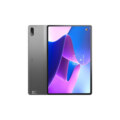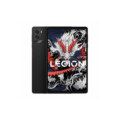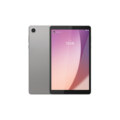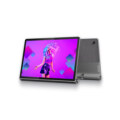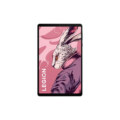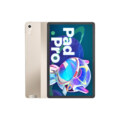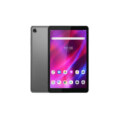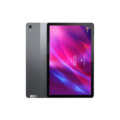Lenovo Tab M10 Gen 3



Specs
General
| Device Type | Lenovo |
| Model | Tab M10 Gen 3 |
| Announced | 01 September, 2022 |
| Status | Available |
Design
| Dimensions | 239.8 x 158.6 x 8.5 mm |
| Weight | 460 g |
| Colors | Storm Grey |
Display
| Refresh Rate | 90 Hz |
| Display Type Display Technology => A number of display technologies and types used in mobile phones => TFT (Thin Film Transistor), IPS (In-Place Switching), OLED (Organic Light Emitting Diode), AMOLED (Active-Matrix Organic Light-Emitting Diode), Super AMOLED (an even advanced version of AMOLED), Resistive Touchscreen (Resistive touchscreens contain two layer of conductive material with a very small gap between them which acts as a resistance), Capacitive Touchsceen (Capacitive touchscreen technology consists of a layer of glass coated with a transparent conductor) | IPS LCD |
| Size | 10.1 inches |
| Resolution | 1200 x 1920 pixels |
| Pixel Density Pixel Density (PPI) is refers to the concentration of pixels on a particular display, measured in pixels per inch (ppi). Pixel density is calculated by dividing the diagonal pixel resolution of a display by its diagonal size, higher pixel density better display quality. | ~ 224 ppi |
| Touch Screen | Capacitive Touchscreen, Multi-touch |
| Features | 320 nits (typ) |
| Secondary Display | No |
Camera
| Front Camera | 5 MP |
| Camera Setup | Single |
| Main Camera Camera is able to capture photographs and usually videos, The most important characteristics of a camera are the resolution (measured in megapixels), lens focus type (fixed or automatic), higher megapixel cameras are known to capture higher quality photos, but not always a good measurement of the photos quality. | 8 MP, AF |
| Video | 1080p@30fps |
| Camera Features | HDR |
Hardware
| Operating System OS => Every computer system run on a base software called Operating System (OS). Operating System controls all basic operations of the computer (such as smartphone, PDAs, tablet computers and other handheld devices). The Operating System allows the user to install and run third party applications (apps), apps are used to add new functionality to the device. | Android 11 |
| Chipset Chipset is a group of integrated circuits designed to perform one or a more dedicated functions, often with real time computing constraints, Popular smartphones are equipped with more advanced embedded chipsets that can do many different tasks depending on their programming. | Unisoc T610 |
| CPU CPU (Central Processing Unit) mostly known as processors, CPU processes instructions in order to carry out certain functions that make your device operate properly. Processors are often described as the brain of computers, smartphones and tablets, Smartphones and tablets rely on processors to carry out their every task, Processors are an incredibly important factor in selecting any type of computing device, including your smartphone. | Octa-core (2x1.8 GHz Cortex-A75 & 6x1.8 GHz Cortex-A55) |
| Architecture | 64 bit |
| Fabrication | 12 nm |
| GPU GPU (Graphics Processing Unit) is a single-chip processor designed to rapidly manipulate and alter memory to accelerate the creation of images in a frame buffer intended for output to a display, This includes things such as lighting effects, object transformations, and 3D motion. | Mali-G52 MP2 |
| RAM (Memory) RAM (Random Access Memory) is a type of computer memory that can be accessed randomly, any byte of memory can be accessed without touching the preceding bytes that allows information to be stored and accessed quickly from random locations. RAM is the most common type of memory found in computer systems, smartphones, tablets and other electronic devices. | 3GB RAM, 4GB RAM |
| Internal Storage Internal Storage is a data storage space (flash memory) mostly used in smartphones, tablets and other electronic devices where operating system, apps, music, photos, videos, files and other user data Is stored. | 32GB / 64GB Built-in |
| Card Slot Memory Card Slot is a special slot for inserting a memory card. Memory cards allow you to expand the phone's built-in memory, A memory card (sometimes called a flash memory card or a storage card) is a small storage medium used to store data such as text, pictures, audio, and video, for use on small, portable or remote computing devices such as mobile phones, mp3 players, digital cameras. | |
| Sensors Sensors are electronic components that detects and responds to some type of input from the physical environment. The specific input could be light, heat, motion, moisture, pressure and location, The output is generally a signal that is converted to use in computing systems, a location sensor, such as a GPS receiver is able to detect current location of your electronic device. | Accelerometer, proximity |
Network
| SIM TYPE SIM (Subscriber Identity Module) is a small card that contains mobile network subscriber's account information. This allows the phone using the card to attach to a mobile network. The SIM card is most commonly associated with GSM and UMTS mobile networks. Moving a SIM card from one phone to another allows a subscriber to switch mobile phones without having to contact their mobile network carrier. SIM cards can also be used by a phone to store limited amounts of data, such as phone numbers and text messages. | Nano SIM |
| SIM Technology | GSM / HSPA / LTE |
| 2G Network | GSM 850 / 900 / 1800 / 1900 |
| 3G Network | HSDPA 850 / 900 / 1900 / 2100 |
| 4G Network | LTE |
Connectivity
| Wi-fi Wi-Fi is a popular wireless networking technology using radio waves to provide high-speed network connections that allows devices to communicate without cords or cables, Wi-Fi is increasingly becoming the preferred mode of internet connectivity all over the world. | Wi-Fi 802.11 a/b/g/n/ac, dual-band, Wi-Fi Direct |
| Bluetooth Bluetooth is a wireless communications technology for exchanging data between mobile phones, headsets, computers and other network devices over short distances without wires, Bluetooth technology was primarily designed to support simple wireless networking of personal consumer devices. | 5.0, LE |
| GPS GPS The Global Positioning System is a satellite-based radio navigation system, GPS permits users to determine their position, velocity and the time 24 hours a day, in all weather, anywhere in the world, In order to locate your position, your device or GPS receiver must have a clear view of the sky. | GPS |
| USB | USB Type-C 2.0, OTG, magnetic connector |
| EDGE EDGE (Enhanced Data GSM Environment) is a wireless network technology generally considered the next step in the 2G network offers data transfer rates up to four times faster than ordinary GSM networks, Generally, EDGE is used for the purpose of wireless data transfer, such as sharing pictures and videos or browsing the Internet via a mobile phone connection. | |
| GPRS GPRS (General Packet Radio Service) is a packet oriented mobile data service on the 2G and 3G cellular communication system's global system for mobile communications (GSM), Generally, GPRS is used for the purpose of wireless data transfer, such as sharing pictures and videos or browsing the Internet via a mobile phone connection. | |
| Speed | HSPA, LTE |
| Wi-fi Hotspot | |
| NFC NFC (Near field communication) is a set of standards for smartphones and similar devices to establish peer-to-peer radio communications with each other by touching them together or bringing them into proximity, usually no more than a few inches. |
Multimedia
| FM Radio | |
| Stereo Speakers | YES |
| Loudspeaker | YES |
| Audio Jack | 3.5mm Audio Jack |
Features
| Messaging | SMS(threaded view), MMS, Email, Push Mail, IM |
| Web Browser Web Browser => a web browser is a software application used to locate, retrieve and display content on the World Wide Web, including Web pages, images, video and other files, The primary function of a web browser is to render HTML, the code used to design or markup webpages. | HTML5 |
| Games | Built-in + Downloadable |
| Torch |
Battery
| Battery Type Battery Type => Cell phones run on various kinds of batteries depending on the manufacturer, phone size or shape and features. There are basically four types of cell phone batteries => Lithium Polymer, Lithium Ion, Nickel Metal Hydride and Nickel Cadmium. | Li-Po |
| Capacity Battery Capacity is a measure (typically in Amp-hr) of the charge stored by the battery, and is determined by the mass of active material contained in the battery. The battery capacity represents the maximum amount of energy that can be extracted from the battery under certain conditions. | 7700 mAh |
| Placement | Non-removable |
| Wireless Charging Wireless Charging (Inductive Charging) uses an electromagnetic field to transfer energy between two objects. This is usually done with a charging station. Energy is sent through an inductive coupling to an electrical device, which can then use that energy to charge batteries or run the device. | No |
| Extra | 20W, PD3.0, QC3 |
Lenovo Tab M10 Gen 3: A Versatile Tablet for Entertainment and Productivity
In today’s fast-paced digital world, tablets have become essential devices that bridge the gap between smartphones and laptops. The Lenovo Tab M10 Gen 3 is a notable entry in the mid-range tablet market, designed to cater to both entertainment enthusiasts and productivity seekers. Here’s a comprehensive look at its features, performance, and overall value.
Design and Build
The Lenovo Tab M10 Gen 3 showcases a sleek and modern design that is both lightweight and portable. It features:
- Dimensions: 247 x 157 x 8.3 mm
- Weight: Approximately 460 grams, making it easy to carry around.
- Materials: The tablet has a plastic back with a matte finish that resists fingerprints, providing a premium feel without the hefty price tag.
- Display: It sports a 10.61-inch IPS LCD display with a resolution of 2000 x 1200 pixels, ensuring vibrant colors and decent viewing angles. The screen is adequately bright for indoor use and offers good visibility outdoors.
Display
The display on the Lenovo Tab M10 Gen 3 is one of its standout features:
- Size: 10.61 inches, which strikes a balance between portability and usability.
- Resolution: 2000 x 1200 pixels, providing sharp visuals for videos, games, and browsing.
- Color Accuracy: The IPS technology enhances color reproduction, making it suitable for watching movies and editing photos.
- Brightness: With a peak brightness of around 400 nits, the display is bright enough for most environments, though direct sunlight may pose a challenge.
Performance
Under the hood, the Lenovo Tab M10 Gen 3 is powered by the MediaTek Helio G90T processor. This chipset is coupled with options for 4GB or 8GB of RAM and 64GB or 128GB of internal storage, expandable via a microSD card slot (up to 256GB). Here’s how it performs:
- Daily Tasks: The tablet handles everyday tasks like browsing, streaming, and social media effortlessly.
- Gaming: While it’s not a gaming powerhouse, it can run casual games and some more demanding titles with moderate settings.
- Multitasking: With the option for 8GB of RAM, multitasking becomes smoother, allowing users to switch between apps without noticeable lag.
Camera
While tablets are not primarily designed for photography, the Lenovo Tab M10 Gen 3 features a decent camera setup:
- Rear Camera: 8 MP sensor capable of capturing reasonable images in good lighting conditions. It’s suitable for scanning documents or casual photos.
- Front Camera: 5 MP sensor, ideal for video calls and social media use. The camera quality is adequate for everyday use, though low-light performance is limited.
Battery Life
The Lenovo Tab M10 Gen 3 is equipped with a 5000mAh battery, which provides impressive endurance:
- Usage: Users can expect up to 10 hours of mixed usage, including browsing, streaming videos, and light gaming. This makes it an excellent companion for long trips or extended use without needing a charger.
- Charging: It supports 10W charging, which is not the fastest on the market, but it gets the job done for overnight charging.
Software
The tablet runs on Android 12 out of the box, providing a user-friendly interface with access to the latest apps and features:
- User Interface: Lenovo’s software customizations are minimal, allowing for a clean Android experience.
- Features: The tablet supports Google Kids Space, making it a great option for families. Parents can create user profiles to monitor usage and content access.
- Updates: Lenovo has committed to regular software updates, ensuring that users will receive new features and security patches over time.
Pros and Cons
Pros:
- Affordable Price: Competitive pricing for the features offered, making it accessible for budget-conscious consumers.
- Good Build Quality: Sturdy design with a lightweight feel.
- Decent Display: High resolution and good color accuracy enhance media consumption.
- Family-Friendly Features: Google Kids Space adds value for families.
Cons:
- Mediocre Performance for Heavy Gaming: Not designed for hardcore gamers; performance may lag in demanding games.
- Average Camera Quality: Cameras are suitable for basic tasks but fall short in low-light conditions.
- Slow Charging: The 10W charging may not be sufficient for users who need quick top-ups.

Conclusion
The Lenovo Tab M10 Gen 3 stands out as a versatile tablet that caters to a wide range of users, from students to casual media consumers. With its attractive design, solid performance for daily tasks, and a family-friendly approach, it offers excellent value for money. While it may not satisfy hardcore gamers or photography enthusiasts, it excels in its primary roles—entertainment and productivity. If you’re in the market for a budget-friendly tablet that doesn’t compromise on quality, the Lenovo Tab M10 Gen 3 is certainly worth considering.
Review
Disclaimer Note
All prices in Pakistan is updated daily from the price list provided by local shops and dealers but we can not guarantee that the information / price on this page is 100% correct (Human error is possible), always visit your local shop for exact cell phone cost & rate.
